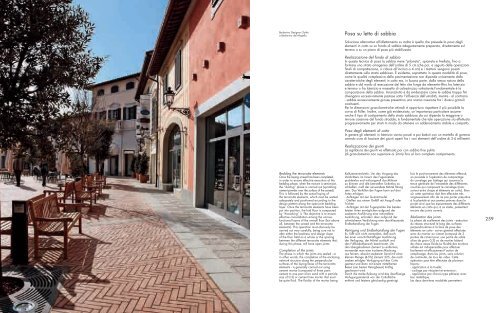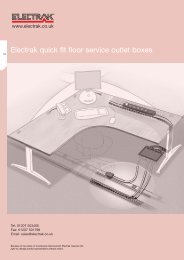by Stone & Sannini - EKA Group
by Stone & Sannini - EKA Group
by Stone & Sannini - EKA Group
You also want an ePaper? Increase the reach of your titles
YUMPU automatically turns print PDFs into web optimized ePapers that Google loves.
Barberino Designer Outlet<br />
a Berberino del Mugello.<br />
Bedding the terracotta elements<br />
Once the laying screed has been completed,<br />
in order to ensure effective execution of the<br />
bedding phase, when the mixture is semi-moist,<br />
the “dusting” phase is carried out (sprinkling<br />
cement powder over the surface of the screed).<br />
This is followed <strong>by</strong> the actual laying of<br />
the terracotta elements, which must be wetted<br />
adequately and positioned according to the<br />
design pattern along the open-joint bedding<br />
layer. Once the terracotta elements have been<br />
put into position, the laid floor is compacted<br />
<strong>by</strong> “thwacking” it. The objective is to ensure<br />
effective consolidation among the various<br />
functional layers of the overall floor (but above<br />
all, between the screed and the terracotta<br />
elements). This operation must obviously be<br />
carried out very carefully, being sure not to<br />
alter either the levelness and design slope<br />
of the floor field as a whole or the spacing<br />
between the different terracotta elements that,<br />
during this phase, still have open joints.<br />
Completion of the joints<br />
The phase in which the joints are sealed - or<br />
in other words, the completion of the enclosing<br />
network structure along the perpendicular<br />
surfaces of the laying faces of the terracotta<br />
elements - is generally carried out using<br />
cement mortar (composed of three parts<br />
cement to one part silica sand with a particle<br />
size of 0.3) or cement lime mortar that must<br />
be quite fluid. The fluidity of the mortar being<br />
Posa su letto di sabbia<br />
Soluzione alternativa all’allettamento su malta è quella che prevede la posa degli<br />
elementi in cotto su un fondo di sabbia adeguatamente preparato, direttamente sul<br />
terreno o su un piano di posa più stabilizzato.<br />
Realizzazione del fondo di sabbia<br />
In questa tecnica di posa la sabbia viene ”pilonata”, spianata e livellata, fino a<br />
formare uno strato omogeneo dell’ordine di 5 cm (che poi, a seguito delle operazioni<br />
finali di compattazione, si riduce all’incirca a 4 cm) e i mattoni vengono posati<br />
direttamente sullo strato sabbioso. È evidente, soprattutto in questa modalità di posa,<br />
come la qualità complessiva della pavimentazione non dipenda unicamente dalle<br />
caratteristiche degli elementi in cotto ma, in buona parte, dalla stessa natura della<br />
sabbia e dal modo di esecuzione del letto che funge da elemento-filtro fra laterizio<br />
e terreno o fra laterizio e massetto di calcestruzzo sottostante.Fondamentale è la<br />
composizione della sabbia. Innanzitutto è da evidenziare come le sabbie troppo fini<br />
divengano eccessivamente pastose sotto l’influenza dell’umidità, mentre - al contrario<br />
- sabbie eccessivamente grosse presentino una scarsa coesione fra i diversi granuli<br />
costituenti.<br />
Per le dimensioni granulometriche ottimali è opportuno rispettare il pìù possibile la<br />
curva di Füller. Inoltre, come già evidenziato, un’importanza particolare assume<br />
anche il tipo di costipamento dello strato sabbioso da cui dipende la maggiore o<br />
minore coesione del fondo stradale; è fondamentale che tale operazione sia effettuata<br />
progressivamente per strati in modo da ottenere un addensamento stabile e compatto.<br />
Posa degli elementi di cotto<br />
In genere gli elementi in laterizio vanno posati e poi battuti con un martello di gomma<br />
avendo cura di lasciare dei giunti aperti fra i vari elementi dell’ordine di 2-4 millimetri.<br />
Realizzazione dei giunti<br />
La sigillatura dei giunti va effettuata poi con sabbia fine pulita<br />
(di granulometria non superiore ai 2mm) fino al loro completo costipamento.<br />
Kalkzementmörteln. Um den Vorgang des<br />
Verdichtens im Innern des Fugennetzes<br />
problemlos und wirkungsvoll durchführen<br />
zu können und alle Leerstellen lückenlos zu<br />
schließen, muß der verwendete Mörtel flüssig<br />
sein. Das Verfüllen der Fugen kann auf drei<br />
Arten erfolgen:<br />
- Auftragen mit der Gummitraufel<br />
- Gießen aus einem Gefäß mit Ausguß oder<br />
Trichter<br />
- Auftragen mit der Fugenpistole Die beiden<br />
letzten Arten ermöglichen aufgrund der<br />
sauberen Ausführung eine rationellere<br />
Ausführung, erfordern aber aufgrund der<br />
schwächeren Verdichtung eine abschliessende<br />
Endbehandlung der Fugen.<br />
Reinigung und Endbehandlung der Fugen<br />
Es läßt sich nicht vermeiden, daß auch<br />
bei einer vorschriftsmäßigen Ausführung<br />
der Verfugung, der Mörtel ausläuft und<br />
den Fußbodenbereich beschmutzt. Um<br />
den übergelaufenen Zement zu entfernen,<br />
verwendet man eine trockene Mischung<br />
aus feinem, absolut sauberem Sand mit einer<br />
kleinen Menge (4-5%) Zement 325, die nach<br />
soeben erfolgter Verfugung auf den Cotto<br />
gestreut und dann mit einem mittelharten<br />
Besen (am besten Reisigbesen) kräftig<br />
gescheuert wird.<br />
Durch die starke Reibung wird das überflüssige<br />
Verfugungsmaterial von der Cottofläche<br />
entfernt und letztere gleichzeitig gereinigt.<br />
fois le positionnement des éléments effectué,<br />
on procède à l’opération de compactage<br />
du carrelage par battage qui assurera la<br />
tenue générale de l’ensemble des différentes<br />
couches qui composent le carrelage (mais<br />
surtout entre chape et éléments en cotto). Bien<br />
sûr cette opération doit être effectuée très<br />
soigneusement afin de ne pas porter préjudice<br />
à la planéité et aux pentes prévues dans le<br />
projet ainsi que les espacements des différents<br />
éléments en cotto qui, à ce stade, présentent<br />
encore des joints ouverts.<br />
Réalisation des joints<br />
La phase de scellement des joints - exécution<br />
du réseau structurel le long des surfaces<br />
perpendiculaires à la face de pose des<br />
éléments en cotto - est en général effectuée<br />
avec du mortier au ciment (composé de 3<br />
parties de ciment pour une partie de sable<br />
silice de grain 0,3) ou de mortier bâtard<br />
de chaux assez fluide.La fluidité des mortiers<br />
utilisés est indispensable pour effectuer<br />
facilement et efficacement l’action de<br />
remplissage, dans les joints, sans solution<br />
de continuité, de tous les vides. Cette<br />
opération peut être effectuée de plusieurs<br />
façons:<br />
- application à la truelle;<br />
- coulage par récipient et entonnoir;<br />
- application par chinois type pâtissier avec<br />
bec métallique.<br />
Les deux dernières modalités permettent<br />
259





